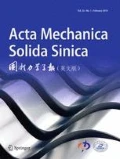Abstract
A novel hybrid graded element model is developed in this paper for investigating thermal behavior of functionally graded materials (FGMs). The model can handle a spatially varying material property field of FGMs. In the proposed approach, a new variational functional is first constructed for generating corresponding finite element model. Then, a graded element is formulated based on two sets of independent temperature fields. One is known as intra-element temperature field defined within the element domain; the other is the so-called frame field defined on the element boundary only. The intra-element temperature field is constructed using the linear combination of fundamental solutions, while the independent frame field is separately used as the boundary interpolation functions of the element to ensure the field continuity over the inter-element boundary. Due to the properties of fundamental solutions, the domain integrals appearing in the variational functional can be converted into boundary integrals which can significantly simplify the calculation of generalized element stiffness matrix. The proposed model can simulate the graded material properties naturally due to the use of the graded element in the finite element (FE) model. Moreover, it inherits all the advantages of the hybrid Trefftz finite element method (HT-FEM) over the conventional FEM and boundary element method (BEM). Finally, several examples are presented to assess the performance of the proposed method, and the obtained numerical results show a good numerical accuracy.
Similar content being viewed by others
References
Miyamoto, Y., Kaysser, W.A., Rabin, B.H., Kawasaki, A. and Ford, R.G., Functionally Graded Materials: Design, Processing and Applications. Dordrecht: Kluwer Academic Publishers, 1999.
Cao, L.L., Qin, Q.H. and Zhao, N., Hybrid graded element model for transient heat conduction in functionally graded materials. Acta Mechanica Sinica, 2012, 28(1): 128–139.
Chen, F.Y. and Jie, W.Q., Finite element design of MgO/Ni system functionally graded materials. Journal of Materials Processing Technology, 2007, 182(1–3): 181–184.
Paulino, G.H., Sutradhar, A. and Gray, L.J., Boundary element method for functionally graded materials. IABEM 2002, University of Texas, Austin.
Sutradhar, A. and Paulino, G.H., The simple boundary element method for transient heat conduction in functionally graded materials. Computer Methods in Applied Mechanics and Engineering, 2004, 193(42–44): 4511–4539.
Wen, J. and Khonsari, M.M., Transient heat conduction in rolling/sliding components by a dual reciprocity boundary element method. International Journal of Heat and Mass Transfer, 2009, 52(5–6): 1600–1607.
Ochiai, Y., Two-dimensional steady heat conduction in functionally gradient materials by triple-reciprocity boundary element method. Engineering analysis with boundary elements, 2004, 28(12): 1445–1453.
Wu, X.H. and Tao, W.Q., Meshless method based on the local weak-forms for steady-state heat conduction problems. International Journal of Heat and Mass Transfer, 2008, 51(11–12): 3103–3112.
Sladek, J., Sladek, V. and Zhang, Ch., Transient heat conduction analysis in functionally graded materials by the meshless local boundary integral equation method. Computational Materials Science, 2003, 28(3–4): 494–504.
Wang, H. and Qin, Q.H., Meshless approach for thermo-mechanical analysis of functionally graded materials. Engineering analysis with boundary elements, 2008, 32(9): 704–712.
Marin, L., Numerical solution of the Cauchy problem for steady-state heat transfer in two-dimensional functionally graded materials. International Journal of Solids and Structures, 2005, 42(15): 4338–4351.
Marin, L. and Lesnic, D., The method of fundamental solutions for nonlinear functionally graded materials. International Journal of Solids and Structures, 2007, 44(21): 6878–6890.
Wang, H., Qin, Q.H. and Kang, Y.L., A meshless model for transient heat conduction in functionally graded materials. Computational mechanics, 2006, 38(1): 51–60.
Wang, H., Qin, Q.H. and Kang, Y.L., A new meshless method for steady-state heat conduction problems in anisotropic and inhomogeneous media. Archive of Applied Mechanics, 2005, 74(8): 563–579.
Anlas, G., Santare, M.H. and Lambros, J., Numerical calculation of stress intensity factors in functionally graded materials. International Journal of Fracture, 2000, 104(2): 131–143.
Li, H., Lambros, J., Cheeseman, B.A. and Santare, M.H., Experimental investigation of the quasi-static fracture of functionally graded materials. International Journal of Solids and Structures, 2000, 37(27): 3715–3732.
Santare, M.H. and Lambros, J., Use of graded finite elements to model the behavior of nonhomogeneous materials. Journal of Applied Mechanics, 2000, 67(4): 819–822.
Gu, P., Dao, M. and Asaro, R.J., A simplified method for calculating the crack-tip field of functionally graded materials using the domain integral. Journal of Applied Mechanics, 1999, 66(1): 101–108.
Wang, H. and Qin, Q.H., Hybrid FEM with Fundamental Solutions as trial functions for Heat Conduction Simulation. Acta Mechanica Solida Sinica, 2009, 22(5): 487–498.
Qin, Q.H., The Trefftz Finite and Boundary Element Method. Southampton: WITpress, 2000.
Qin, Q.H. and Wang, H., Matlab and C Programming for Trefftz Finite Element Methods. CRC Press, 2008.
Wang, H. and Qin, Q.H., Boundary integral based graded element for elastic analysis of 2D functionally graded plates. European Journal of Mechanics—A/Solids, 2012, 33: 12–23.
Cen, S., Fu, X.R. and Zhou, M.J., 8- and 12-node plane hybrid stress-function elements immune to severely distorted mesh containing elements with concave shapes. Computer Methods in Applied Mechanics and Engineering, 2011, 200(29–32): 2321–2336.
Berger, J.R., Martin, P.A., Mantic, V. and Gray, L.J., Fundamental solutions for steady-state heat transfer in an exponentially graded anisotropic material. Journal of Applied Mathematics and Physics (ZAMP), 2005, 56(2): 293–303.
Gray, L.J., Kaplan, T., Richardson, J.D. and Paulino, G.H., Green’s functions and boundary integral analysis for exponentially graded materials: heat conduction. Journal of Applied Mechanics, 2003, 70(4): 543–549.
Wang, H. and Qin, Q.H., Some problems with the method of fundamental solution using radial basis functions. Acta Mechanica Solida Sinica, 2007, 20(1): 21–29.
Wang, H. and Qin, Q.H., A meshless method for generalized linear or nonlinear Poisson-type problems. Engineering analysis with boundary elements, 2006, 30(6): 515–521.
Author information
Authors and Affiliations
Corresponding author
Additional information
The research in this paper is partially supported by the Special Fund for Basic Scientific Research of Central Colleges, Chang’an University (Project No. CHD2011JC150) and the National Natural Science Foundation of China (No. 11102059).
Rights and permissions
About this article
Cite this article
Cao, L., Wang, H. & Qin, QH. Fundamental Solution Based Graded Element Model for Steady-State Heat Transfer in FGM. Acta Mech. Solida Sin. 25, 377–392 (2012). https://doi.org/10.1016/S0894-9166(12)60034-2
Received:
Revised:
Published:
Issue Date:
DOI: https://doi.org/10.1016/S0894-9166(12)60034-2




